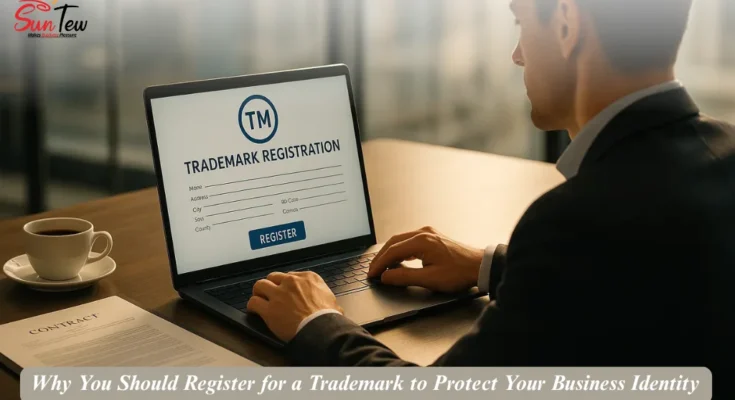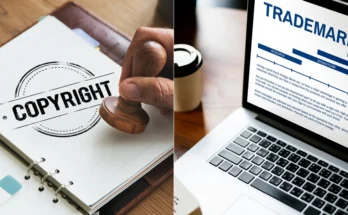Introduction
In today’s digital marketplace, your brand is often discovered before your business is. Competitors, copycats, and domain squatters can confuse customers and siphon hard-won trust unless you lock down your identity. “When you register for a trademark, you secure your business identity and stand out from imitators.” A trademark grants exclusive rights over your brand name, logo, or tagline across specific goods and services, so buyers can recognise you instantly and avoid fakes. Beyond legal protection, registration signals professionalism, boosts credibility on eCommerce platforms and app stores, and makes takedowns of impersonators faster. It also strengthens SEO and marketplace visibility by linking authentic listings to your official mark. Whether you’re launching a startup or scaling nationally, moving early reduces risk and future disputes. We’ll show why it matters, how the trademark and registered trademark differ, and the exact steps to file. If protecting reputation, revenue, and customer trust matters to you, begin with one action: register for a trademark.
For more info: contact us
What Is a Trademark and Why Does It Matter
A trademark is a distinctive sign that identifies the source of your products or services. It can be a brand name, logo, slogan, stylised word, or even a unique sound or colour consumers associate with you. By acting as a badge of origin, a mark helps buyers find you in crowded marketplaces and reduces confusion. The difference between a trademark and a registered trademark is simple: the ™ symbol can be used to claim rights in a mark you are using, while the ® symbol is reserved only after successful government registration. Registration expands protection, enables enforcement, and unlocks formal remedies against imitators. Think of Nike’s Swoosh or Apple’s bitten apple—these symbols instantly signal quality, origin, and reputation worldwide. That recognition exists because of diligent trademark and registration strategies built over decades. For growing businesses, the benefit is practical: stronger rights, clearer ownership, and faster takedowns on e-commerce and social platforms. In short, trademarks convert reputation into legally protected equity. They also define ownership across specific classes, create a public record that deters lookalikes, and signal seriousness to investors and marketplaces. With a clear title, disputes drop. Ultimately, trademarks protect customers from confusion and reward businesses that deliver consistent quality over time.
For detailed information: https://suntew.biz/blog/what-is-trademark-and-why-its-important-for-a-company/
Benefits of Registering for a Trademark
Registering your mark converts goodwill into enforceable rights that you can utilise. Here’s what you gain when you register for a trademark and complete trademark and registration properly:
- Strong legal shield: Registration creates a public record and class-based exclusivity, allowing you to prevent confusingly similar names and logos, recover damages, and secure takedowns on marketplaces and social media.
- Trust and recognition: The ® symbol signals authenticity. Customers, distributors, and platforms view you as the original, which lifts click-throughs, conversions, and repeat purchases.
- Higher valuation: A registered mark is an intangible asset that can be licensed, franchised, or pledged. It strengthens due diligence for investors and increases enterprise value.
- Digital brand protection: Enforce your rights on domains, app stores, eCommerce listings, and ads. Platform policies favour owners with certificates, making impersonation removals quicker.
- Smoother expansion: As you enter new regions, a home registration supports filings abroad (e.g., Madrid Protocol) and helps customs block counterfeit imports.
- Competitive moat: Unique branding becomes harder to copy, letting you preserve pricing power and reduce paid media waste caused by lookalike confusion.
- Operational clarity: Clear ownership prevents internal disputes among founders or partners and guides consistent brand usage across teams and vendors.
- Longevity: With renewals, rights can last indefinitely, letting identity compound in value over decades.
In short, when you register for a trademark, you align marketing with law. The result is fewer disputes, cleaner customer journeys, and valuable assets that appreciate as you grow protection that pays for itself over time.
Trademark Registration Process Explained
Here is a clear, practical walkthrough of the trademark register process from idea to certificate.
- Trademark search: Begin with a comprehensive clearance search across trademark registers, domains, app stores, and marketplaces. Check identical and “confusingly similar” spellings, translations, and logos. Confirm the mark is distinctive, not descriptive or generic within your class.
- Choose classes and goods/services: Identify the Nice courses that cover what you sell today and plan to sell soon. Draft precise descriptions that reflect real use to avoid overbroad claims.
- File the application: You can register a trademark online via the official portal or file through an attorney or agent. Provide applicant details, representation of the mark, class selection, priority (if any), and a dated specimen of use or intent-to-use declaration.
- Examination: The trademark office reviews formalities and substantive issues, such as distinctiveness and conflicts. Respond promptly to office actions or objections with evidence, clarifications, or amendments.
- Publication/opposition: If accepted, the mark is published in the trademark journal. Third parties may oppose within a set window. Prepare to negotiate coexistence, limit goods/services, or submit arguments to overcome opposition.
- Registration and certificate: Absent opposition—or after a successful defence—the office issues a registration certificate. Start using the ® symbol and maintain accurate ownership records.
- Maintenance: Docket Renewals and Use Requirements. Non-use in many jurisdictions can lead to cancellation.
Tips to avoid refusal or delay: run a deep search before filing; keep the mark distinctive; select the right classes; ensure consistent owner name across filings; submit high-quality logo artwork; answer examiner queries on time; monitor your published application for oppositions; and keep proof of use handy.
When you follow this trademark registration process and register a trademark online with care, you reduce risk, speed approval, and strengthen enforceable rights from launch.
How to Register a Trademark Online
Most businesses can complete filing end-to-end online in a few hours. To register a trademark online, follow these steps.
- Pick your filing office: India (IP India e-Filing), United States (USPTO TEAS), European Union (EUIPO), United Kingdom (UK IPO), or Australia (IP Australia). Reputable legal platforms can submit on your behalf.
- Create an account and select a mark type: word mark, logo/device, or combined. Choose relevant Nice classes and draft precise goods/services.
- Gather documents: owner details, email, artwork (high-contrast PNG/SVG), description, first-use or intent-to-use, priority claim (if any), and power of attorney when an agent files. Some offices require a digital signature.
- Pay the fee and submit. Save the application number and receipt.
Actionable tips for faster approval:
- Run a proper clearance search before filing.
- Prefer a standard-character word mark first; add the logo later.
- Avoid generic or descriptive wording; keep it distinctive.
- Match the owner’s name across all records.
- Use accurate, class-appropriate descriptions—avoid catch-all lists.
- Monitor your inbox and diary objection/opposition deadlines.
- Turn on watch services to spot copycats early.
Keep proof of use.
This online workflow aligns your trademark and registration plan with enforcement, speeding examination and strengthening rights from day one.
Common Mistakes to Avoid When Registering
Even strong businesses stumble at the filing stage. Avoid these costly errors:
- Generic or descriptive names and look-alike logos. If consumers see your mark as common language or a basic shape, examiners can refuse it. Aim for distinctive words or invented terms before you register for a trademark.
- Skipping a full clearance search. Check identical and similar marks across classes, spellings, and translations; also search domains, apps, and marketplaces.
- Misclassifying goods/services. Map today’s offers and near-term expansions to the correct Nice classes; vague catch-alls invite objections and narrow protection.
- Inconsistent ownership data. The legal entity on invoices, branding, and filings must match.
- Ignoring deadlines. Missed office-action replies, opposition windows, renewals, or proof-of-use filings can lead to the loss of trademark and registration.
- Filing only a logo. File a word mark if possible, then the device.
- Document real use, monitor publication, and keep records ready for enforcement and audits.
Cost and Timeframe of Trademark Registration
Costs and timelines vary by country, depending on whether you use an attorney. Expect two expense buckets: government filing fees per class, and professional fees for searches, drafting, and responses. Across major jurisdictions, a budget ranges from low three figures to low four figures in US dollars per mark. Timelines typically run six to eighteen months: application, examination, publication, and then registration. Delays arise when examiners raise objections or third parties oppose the mark. To control costs, define a precise list of goods and services, file a distinctive word mark first, and respond to office actions promptly. A clearance search often prevents costly objections. If you plan to register for a trademark in multiple regions, sequence filings strategically, claim priority, or use the Madrid Protocol to leverage earlier dates. Bottom line: the trademark register process is predictable but procedural. Professional guidance usually pays for itself through fewer delays, stronger rights, and cleaner enforcement.
Trademark Renewal and Protection Tips
Most countries require renewal every 10 years from the filing or registration date, with grace periods and late fees if you miss the window. Calendar renewals early, record owners correctly, and keep specimens of use ready. Build a comprehensive monitoring stack that includes official trademark gazettes, marketplace brand registries, domain and social handle monitors, and ad platforms. Set alerts for confusingly similar names, phonetic variants, and transliterations. When you see misuse, send a firm notice, escalate to platform takedowns, and preserve evidence and robust documentation. Use the ® symbol only after successful registration; use ™ beforehand. Correct symbol usage strengthens your position and deters copycats. Align marketing, legal, and operations in one playbook for trademark and registration: brand guidelines, authorised logo files, approved goods/services, and enforcement steps. Train partners and agencies to avoid off-brand marks. Regular audits ensure your trademark and registered trademark stay distinctive, appropriately used, renewed on time, and defensible worldwide.
Contact us: +91 9538866551, +91 8951500340
Mail ID: suntew.biz@gmail.com, mangalore@live.in
Mangalore: Mothisham Emporium Building, Ground Floor, Mohtisham, Old, Pumpwell Cir, Kankanady, Mangaluru, Karnataka 575002
Bangalore: Parvathamma Complex, 6th Main, Dr Siddayya Puranik Road, Basaveshwara Nagrabangalore-560079
Conclusion: Why Every Business Should Register for a Trademark
Every sale, review, and referral builds equity in your brand. Without formal protection, that value is vulnerable to copycats, impostor listings, and domain squatters. When you register for a trademark, you convert reputation into exclusive rights—rights you can enforce across marketplaces, ads, and new regions. Registration reduces confusion, increases trust, and raises your company’s valuation by turning your mark into an owned asset. It’s not a legal formality; it’s a long-term moat around your identity. The next step is simple: conduct an intelligent clearance search, pick the correct classes, and register the trademark online via your national office or a trusted professional. Protect your business today file, monitor, and use the ® symbol once approved. Safeguard your brand’s future and grow with confidence.



